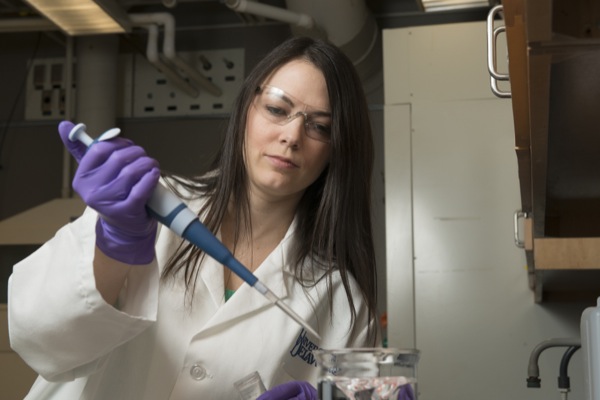
UDRF awards 11 new projects
Research topics range from triple-negative breast cancer to storm hazards
1:21 p.m., Aug. 6, 2014--The University of Delaware Research Foundation (UDRF) has funded 11 projects by UD faculty in areas ranging from triple-negative breast cancer to storm hazards.
A private corporation chartered in 1955, UDRF sponsors an annual funding competition for early career, untenured, and tenure-track faculty across the sciences and engineering at the University.
Research Stories
Chronic wounds
Prof. Heck's legacy
Investigators are eligible for grants of up to $35,000. The awards include $25,000 in UDRF funding, which is matched by $5,000 from the provost and $5,000 from the awardee’s respective college dean.
“For decades, the University of Delaware Research Foundation has provided valuable seed funding to tenure-track faculty early in their careers,” said Charlie Riordan, vice provost for research. “This year’s cadre of award recipients includes faculty members from five colleges highlighting the breadth of research excellence at UD. The funding will be used by our new colleagues to collect preliminary research data necessary for them to prepare nationally competitive proposals in the current hyper-competitive federal and private sector research funding climate.”
The funded projects include the following:
- A first step toward a new breast cancer treatment — Emily Day, assistant professor of biomedical engineering, will explore the potential of photothermally active spherical nucleic acids (SNAs) as a next-generation therapy for triple-negative breast cancer, an aggressive disease that grows quickly and metastasizes early.
- Designing nanostructures for advanced thermoelectric materials — Joseph Feser, assistant professor of mechanical engineering, will analyze the scattering of heat particles called phonons from embedded nanostructures to identify the characteristics that will advance the design of thermoelectric materials with ultra-low heat flow for use in power generation and refrigeration.
- Why are women more likely to leave STEM fields? — Chad Forbes, assistant professor of psychological and brain sciences, will focus on understanding why women who are initially the most invested and motivated to succeed in science, technology, engineering and mathematics (STEM) faculty positions and other careers are ironically the most likely to leave such fields.
- Uncovering the neurobiological mechanisms of post traumatic stress disorder (PTSD) — Dayan Knox, assistant professor of psychological and brain sciences, will test the hypothesis that enhanced interactions between the glucocorticoid receptor, to which the stress hormone cortisol binds, and enzyme kinases in the ventral hippocampus during fear memory consolidation leads to abnormal fears.
- A coupled wave-ocean modeling system to assess coastal Delaware storm hazards — Tobias Kukulka, assistant professor of physical ocean science and engineering, will validate a hydrodynamic model for predicting coastal storm surges during tropical cyclones and northeasters by comparing simulations of currents and surface waves along the Delaware coast with existing observations.
- Advancing physical rehabilitation after stroke — Susanne Morton, associate professor of physical therapy, will test whether traditional physical therapy paired with safe, non-invasive brain stimulation (transcranial direct current stimulation – tDCS) can improve the recovery of motor function in stroke patients compared to traditional therapy alone.
- Investigating ionic liquid – gas uptake — John Newberg, assistant professor of chemistry and biochemistry, will shed light on the interaction of molecules at the gas-ionic liquid interface using a transformative new technology known as ambient pressure X-ray photoelectron spectroscopy (APXPS) housed in UD’s Interdisciplinary Science and Engineering Laboratory (ISE Lab).
- Using optogenetics to uncover osteocyte behavior — Christopher Price, assistant professor of biomedical engineering, will apply optogenetic techniques, which use light to control cells engineered to express photoactivatable ion channels, in a novel study of bone cells (osteocytes). Such techniques have been used to map neural signaling and behavioral pathways in living organisms and now will be applied to musculoskeletal research.
- Determining whether sex impacts neonatal immunity — Jaclyn Schwarz, assistant professor of psychological and brain sciences, will test the hypothesis that boys may be more vulnerable than girls to neurodevelopmental disorders such as autism, ADHD, schizophrenia and cerebral palsy because of the increased numbers of microglia, or resident immune cells, in the brain that may make boys vulnerable to early life events that impact the immune system.
- Understanding how silicon can affect arsenic levels in rice — Angelia Seyfferth, assistant professor of plant and soil sciences, will examine the impact of increasing dissolved silicon in rice paddies as a mitigation strategy to decrease the uptake of arsenic by rice, one of the most important food crops in the world.
- Creating a new drug screening model — John Slater, assistant professor of biomedical engineering, will develop a methodology to fabricate highly vascularized microfluidic systems embedded in synthetic matrices to mimic the architecture and transport properties of native tissue. The synthetic model will be implemented for high throughput drug screening applications to lower the cost associated with new drug development.
- The Neural Basis of Reward Learning — Timothy Vickery, assistant professor of psychological and brain sciences, will examine how learned associations between rewards and visual stimuli play a central role in human decision-making. Human neuroimaging (fMRI) will be used to assess the connectivity of human visual regions with reward learning regions during high or low monetary outcomes.
Photo by Evan Krape








